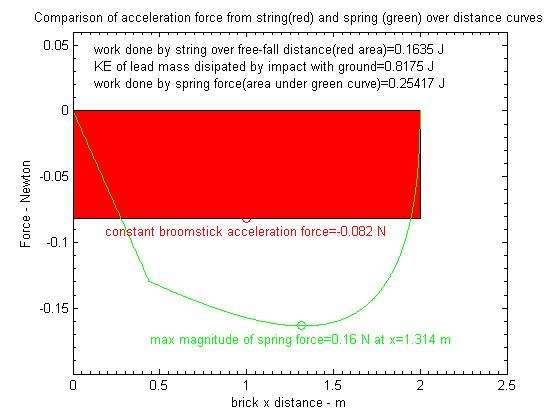Merlin,Merlin wrote:Aitor, I'm lagging behind now, but I prepared that post and let you know about it:
We can set up two experimental conditions and get two opposite results. It is just a question of tuning (spring stiffness, masses, falling height).
I am trying again to explain what is behind the dynamics of fly rods. We all know there are a variety of them, built for different purposes (at least the range of weight they can cast). The basic principle to give speed to the line is to move a force at tip in the direction of the cast. Using a spring offers the opportunity to do so by comparison to a broomstick. But to be efficient, we have to define the main characteristic of the spring, its stiffness, in relation with the weight of line we cast. As I told above, I can choose a set of conditions that will make the broomstick at least as performing than a flexible lever (maximum line speed).
In the case of an absolutely rigid rod (broomstick), the force at tip is the direct consequence of the acceleration in rotation of the rod, and when the maximum rotation speed is achieved, the line is released. If we use a spring we change the force at tip. The usual vision is that the tip is lagging at start (little force on the line), then it accelerates drastically (the force at tip can be the double than the one in the broomstick case) and the force can travel over a long distance beyond the place where the rotation speed is maximum (during the deceleration of the butt). This is not for free because the corresponding energy is provided by the caster which has to move the rod and compress the spring.
The misconception is to think that the spring will compress until the final stop of the rod and that from this moment, the elastic energy contained in the spring is given back to the line. This may be the reason why so many people looked after the amount of energy stored in the spring as relevant of the casting efficiency. But this is not the way it works; it works because the caster can move a significant force over a long distance (by comparison to the rigid rod). This force varies in time and can be smaller or higher than in the case of the broomstick, but at the end of the day, if the system is properly tuned, the energy in the line is larger than the one obtained with the broomstick. The elastic energy in the rod is mainly converted in loop shaping and kinetic energy of the rod which causes the counter flex, and maybe a small part is directly converted in line energy.
Now let’s come back to the reason explaining why the cast can be more or less efficient depending on the various parameters which affect it. First point: the more energy one puts in a cast, the larger the rod deflection is. Second point: this is not true for speed; there is an optimum somewhere around 50% (+/- 10%) relative deflection depending on the non linearity of the rod.
There is an upper limit and a lower limit to rod stiffness. Since we need to move a force, this force needs to occur as the rod butt is rotating, either in acceleration or deceleration. If RSP is achieved before the end of rotation (stiff rod), then the line is launched before the end of rotation and energy has not been introduced into the system. If the rotation is stopped before the rod has completely unloaded, some force will not be moved and again we lose an opportunity to feed energy in the line.
So the designer’s job is at least to offer a rod that will react positively (the caster will be able to generate energy in a given space frame and time frame). He then has to tune its stiffness for the line one wants to cast. The energy is generated as the spring is loading and unloading during the butt rotation. The idealized situation is to get RSP as the rod is stopped, then energy is produced under optimum conditions (moving force). As the conditions of the cast are changing (line length), the caster has to adapt his motion to stay close to that optimum. Since the mechanical system is somehow tolerant with modern rods, there is some room for error without losing a significant amount of speed, but this is why no one tries to sell you a noodle or a broomstick for fishing.
I think you can realize why defining the condition of the experiment is crucial. As I said we could select conditions to fail demonstrating the way to use a spring properly. I worked on the “trebuchet” parameters to see what we could do. The main point today is to know the stiffness of the candidate rods. It would be nice to be able to demonstrate opposite results by tuning the system accordingly. I think this would avoid finding a good reason not to believe into the experiment. Now we have to define the criteria that will tell us the outcome of the experience. To me you need a high speed camera to measure the launching speed of the mass you intend to put at the tip level in the trebuchet experiment. Maybe the launching angle will be different; I think we can also record it with a camera.
I understand that Lasse has strated his own experience, so thanks to you Lasse if you can provide us with the parameters of your experiment (spring stiffness, masses, height of fall).
Merlin
I find this to be a very good and understandable summary of the whole issue. Thanks.
I will try to find time to pose some questions about it.

